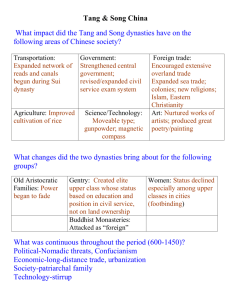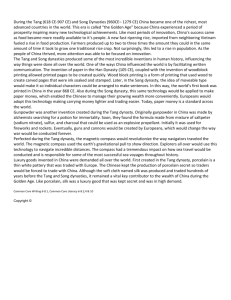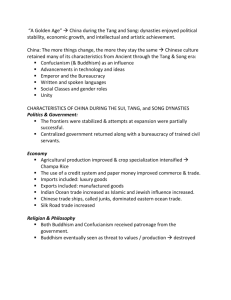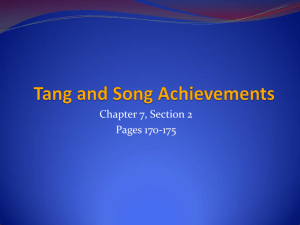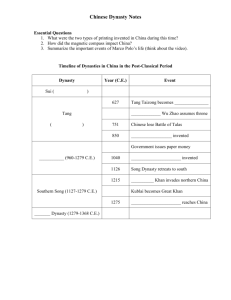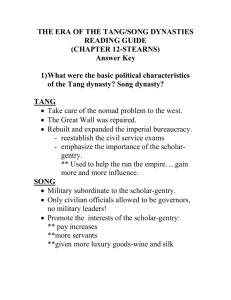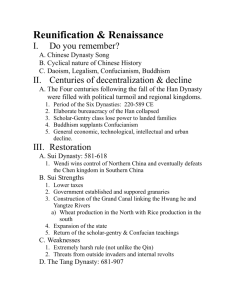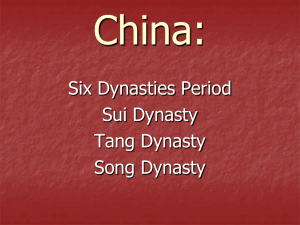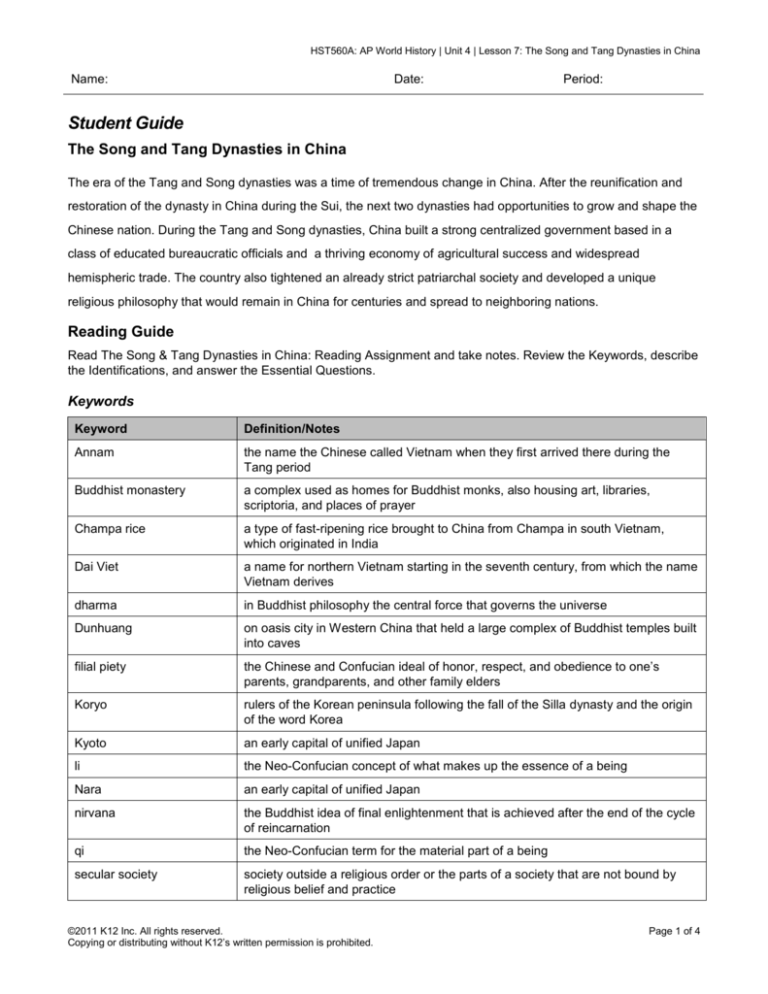
HST560A: AP World History | Unit 4 | Lesson 7: The Song and Tang Dynasties in China
Name:
Date:
Period:
Student Guide
The Song and Tang Dynasties in China
The era of the Tang and Song dynasties was a time of tremendous change in China. After the reunification and
restoration of the dynasty in China during the Sui, the next two dynasties had opportunities to grow and shape the
Chinese nation. During the Tang and Song dynasties, China built a strong centralized government based in a
class of educated bureaucratic officials and a thriving economy of agricultural success and widespread
hemispheric trade. The country also tightened an already strict patriarchal society and developed a unique
religious philosophy that would remain in China for centuries and spread to neighboring nations.
Reading Guide
Read The Song & Tang Dynasties in China: Reading Assignment and take notes. Review the Keywords, describe
the Identifications, and answer the Essential Questions.
Keywords
Keyword
Definition/Notes
Annam
the name the Chinese called Vietnam when they first arrived there during the
Tang period
Buddhist monastery
a complex used as homes for Buddhist monks, also housing art, libraries,
scriptoria, and places of prayer
Champa rice
a type of fast-ripening rice brought to China from Champa in south Vietnam,
which originated in India
Dai Viet
a name for northern Vietnam starting in the seventh century, from which the name
Vietnam derives
dharma
in Buddhist philosophy the central force that governs the universe
Dunhuang
on oasis city in Western China that held a large complex of Buddhist temples built
into caves
filial piety
the Chinese and Confucian ideal of honor, respect, and obedience to one’s
parents, grandparents, and other family elders
Koryo
rulers of the Korean peninsula following the fall of the Silla dynasty and the origin
of the word Korea
Kyoto
an early capital of unified Japan
li
the Neo-Confucian concept of what makes up the essence of a being
Nara
an early capital of unified Japan
nirvana
the Buddhist idea of final enlightenment that is achieved after the end of the cycle
of reincarnation
qi
the Neo-Confucian term for the material part of a being
secular society
society outside a religious order or the parts of a society that are not bound by
religious belief and practice
©2011 K12 Inc. All rights reserved.
Copying or distributing without K12’s written permission is prohibited.
Page 1 of 4
HST560A: AP World History | Unit 4 | Lesson 7: The Song and Tang Dynasties in China
Keyword
Definition/Notes
Dao
in native Chinese philosophy, the force that governs right and wrong in the
universe
Identifications
Describe the Identifications. Use names, events, dates, and works of art or literature to help describe the
identification.
Identifications
Description/Notes
flying cash
inflation
Guangzhou
Quangzhou
Chang’an
Zuoyang
Yamato
Taika reforms
Empress Suiko
Great Buddha
Red River Valley
Mekong Valley
Yangzi River
Hangzhou
Confucianism
©2011 K12 Inc. All rights reserved.
Copying or distributing without K12’s written permission is prohibited.
Page 2 of 4
HST560A: AP World History | Unit 4 | Lesson 7: The Song and Tang Dynasties in China
Identifications
Description/Notes
Buddhism
Zhu Xi
Chan Buddhism
Mahayana Buddhism
neo-Confucianism
Shinto
Silla dynasty
Son Buddhism
universal sagehood
wuwei
Zen Buddhism
footbinding
shamanism
Essential Questions
Answer the following questions from your reading:
1. Why did a market economy emerge in Tang and Song China?
©2011 K12 Inc. All rights reserved.
Copying or distributing without K12’s written permission is prohibited.
Page 3 of 4
HST560A: AP World History | Unit 4 | Lesson 7: The Song and Tang Dynasties in China
2. What was the relationship between economic growth in the Tang and Song dynasties and the stimulation
of trade and production in much of the Eastern Hemisphere for more than seven hundred years?
3. What was the role of women in Chinese society?
4. What were culture and religion like during the Song dynasty?
5. What cultural changes took place in Tang and Song China?
Map Practice
Return to the online portion of the lesson and complete the map activity.
©2011 K12 Inc. All rights reserved.
Copying or distributing without K12’s written permission is prohibited.
Page 4 of 4

